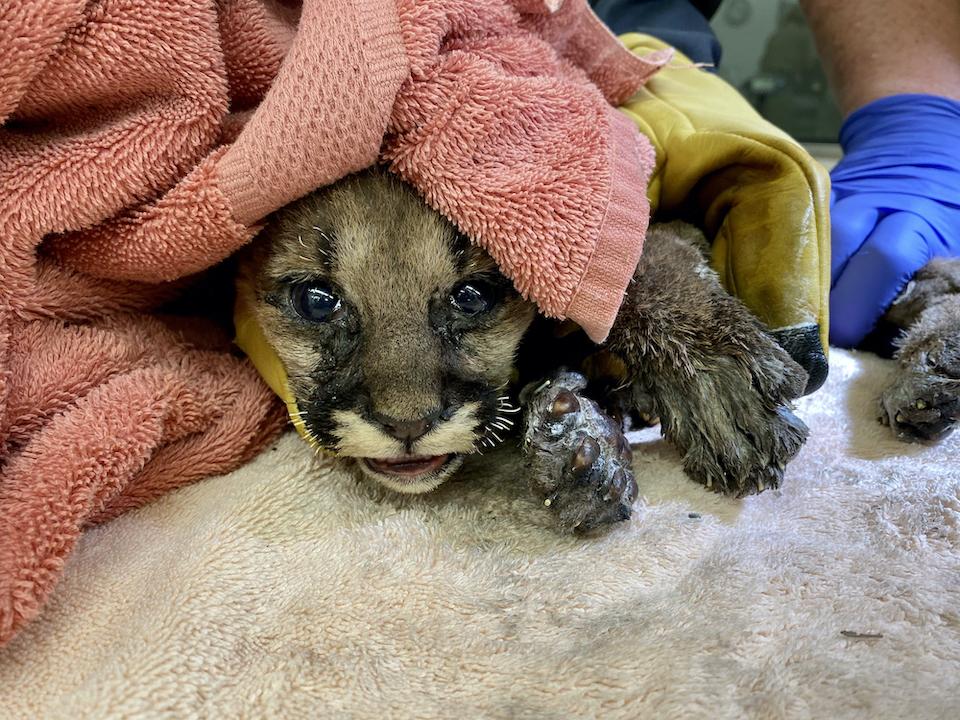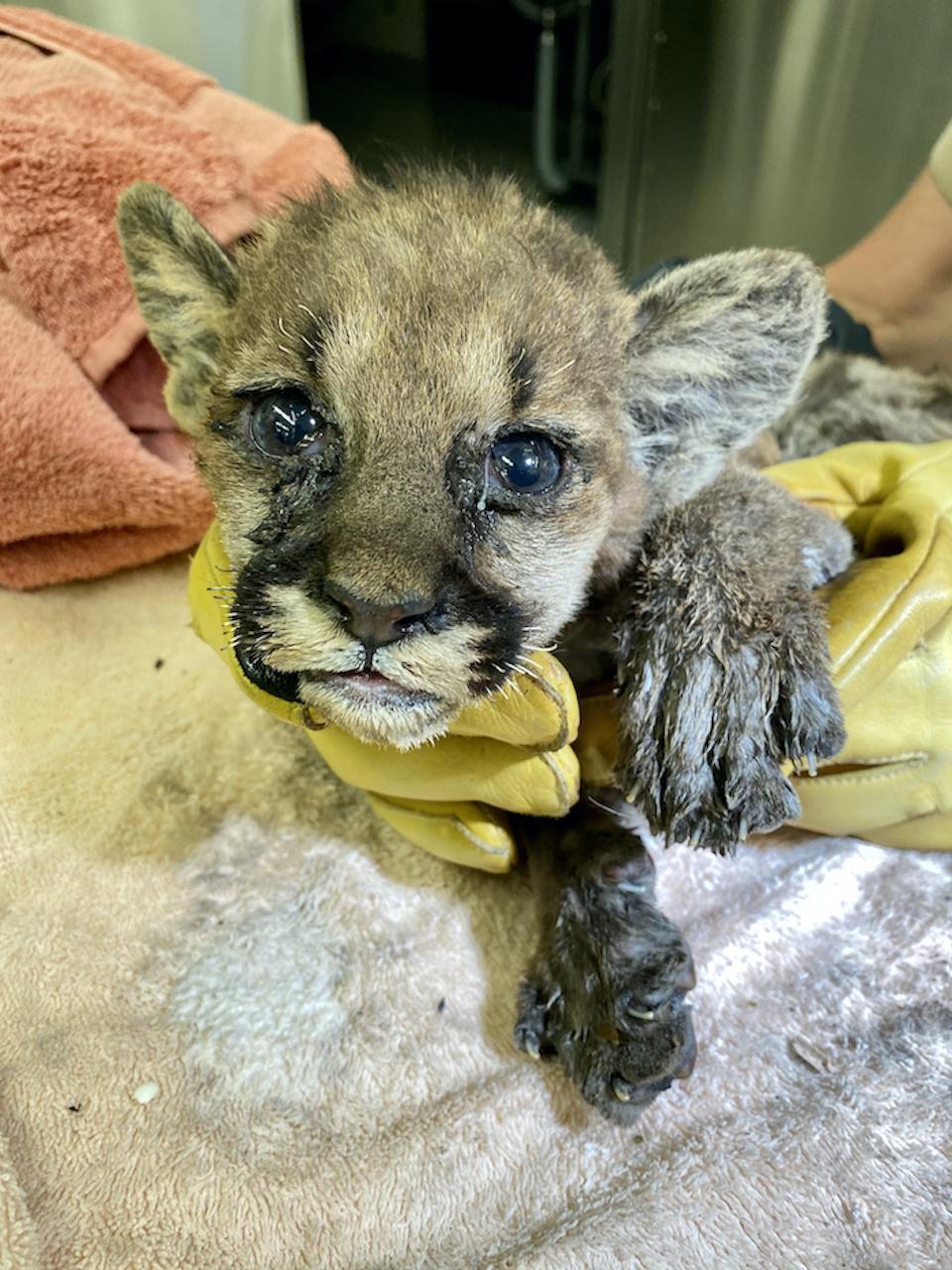
The burned mountain lion cub upon arrival at Oakland Zoo veterinary hospital/Oakland Zoo
In a twist on the Smokey Bear story, an orphaned mountain lion cub, thought to be less than two months old, was rescued from the flames of the Zogg Fire in California by a firefighter and sent to the Oakland Zoo for veterinary care of its burns.
The cub was found Wednesday. After Cal Fire contacted the Shasta County Sherriff Department, it in turn contacted the California Department of Fish and Wildlife. CDFW veterinarians, who are tirelessly working to save the lives of so many wildlife victims trapped by the recent fires throughout California, then contacted Oakland Zoo veterinarians for help in treating the cub.
Oakland Zoo’s veterinary team was standing by to receive and treat the cub, which arrived at 7:15 p.m. Wednesday.
“We are so grateful for the Oakland Zoo’s expertise, world-class facilities and willingness to step up – on extremely short notice – to help wildlife in need,” said CDFW’s senior wildlife veterinarian Dr. Deana Clifford. “Partnerships like this are absolutely critical to our state’s efforts to provide emergency care. California’s wildfires are erupting on a scale that we’ve never seen before, and we expect that we’ll have more burn patients than we have the capacity to treat in our own veterinary facility.
“Unfortunately, a lion this size is too small to be released back into the wild, but we are hopeful that under the zoo’s care, it will get a second chance as an ambassador for its species.”

The burned mountain lion cub upon arrival at Oakland Zoo veterinary hospital/Oakland Zoo
Oakland Zoo’s Dr. Lynette Waugh, along with staff veterinary technicians, examined and treated the very young male cub, which weighed less than 4 pounds. The cub was badly burned, especially his paws. His whiskers were completely singed off, and there was severe irritation to his eyes as well.
The veterinary team cleaned the cub, administered antibiotics, supportive fluids, pain medication, and fed milk formula for kittens (through a syringe). Dr. Alex Herman at Oakland Zoo explained that after treatment the cub was eating on his own and acting feisty – both promising signs for his recovery.
Zoo veterinarians performed X-rays Thursday to determine if there was damage to the cub's lungs from smoke inhalation or any bone damage to his paws. Aside from severe burns to the soft tissue of the paws, there was no damage to bones or lungs, the zoo reported.
The Zogg Fire is burning near Whiskeytown National Recreation Area in northern California. As of Thursday it covered more than 55,000 acres, with containment lines reported around 26 percent of the blaze.
Oakland Zoo's veterinary team is also working with UC Davis Veterinary Medicine Teaching Hospital for their expertise in providing the most advanced care in treating the cub’s burn wounds.
“We’re grateful to be part of this amazing little cub’s rescue and rehabilitation. It’s an amazing effort between Cal Fire, the Shasta County Sherriff’s Department, and of course our partners at the California Department of Fish & Wildlife," said Dr. Alex Herman, the zoo's veterinary hospital director. "In the past two years, this marks our thirteenth mountain lion cub rescue for Oakland Zoo in partnership with CDFW. We’re cautiously optimistic that this cub will now survive and thrive, our dedicated team at Oakland Zoo is fully committed to do everything we can for him and for his beautiful species.”
Smokey Bear, of course, was an orphaned and injured black bear cub found by firefighters in the Capitan Mountains of New Mexico in 1950. It later became a U.S. Forest Service ambassador for combating carelessness that led to wildfires.
Aside from wildfires, mountain lions are facing numerous threats in California; often struck by cars and illegally poached. These factors culminate in the human-wildlife conflict, putting them at odds with humans in encroaching urban areas and developments. Oakland Zoo partners with conservation organizations like the Mountain Lion Foundation and the Bay Area Puma Project to educate the public on the issue and help conserve the species in the wild.
In the wild, mountain lion cubs stay with their mothers until they are around two years of age in order to learn the skills to survive on their own. Because this cub is orphaned and now unable to learn how to survive in the wild, he will be placed in a suitable forever home once he’s ready to leave Oakland Zoo’s Veterinary Hospital.



Comments
Fortunately this cub was rescued. I mourn the cub's mother and other wild animals that have died because of fires exacerbated by human-caused climste change.
Long life, health and freedom to this young wild one. Thank you to all who rescue and treat the animals who are victims of these terrible fires.